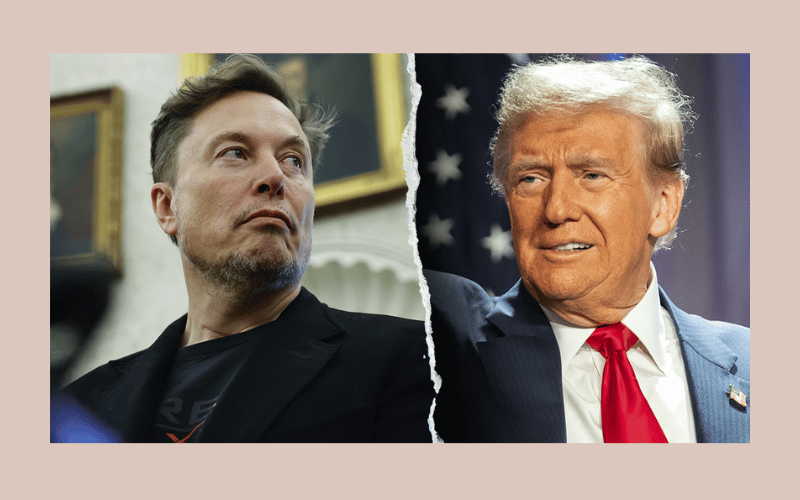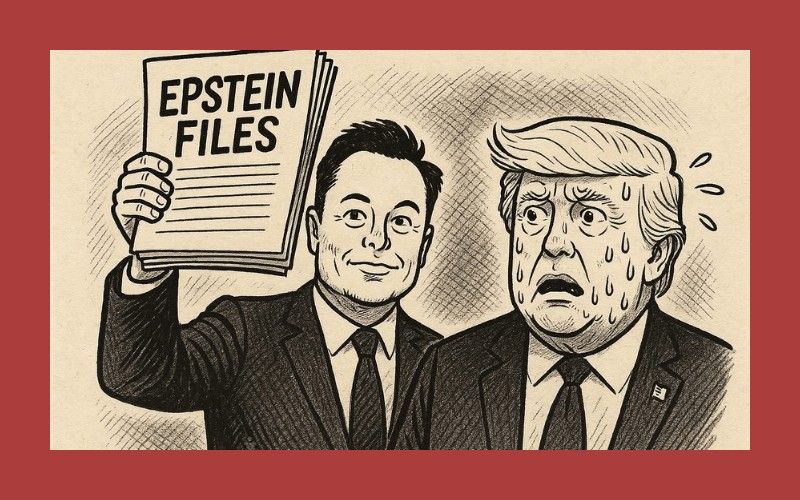Marketing in the digitalized world of 2025 is not about some inanimate advertisements and conventional PR messages anymore. Now, memes are one of the most effective tools in a marketer’s toolkit: viral, immediate, funny, and strongly appealing to the younger generations. Meme marketing indeed assisted in demonstrating its strength in the case of the online fight that, by its sudden and flamethrower nature, turned out to be between two of the most powerful individuals on the globe, Elon Musk and Donald Trump. A political dispute about a trillion-dollar spending bill soon became a media spectacle revolving around memes. This Twitter feud provided an excellent meme marketing case study that has never been seen before in terms of how memes can influence the discourse in society, increase the level of engagement, and even affect the financial markets.
1. How It All Started: A Tweet Sparks a Firestorm
The drama began at the beginning of June 2025, when Elon Musk, on his platform, X (previously Twitter), criticized a 1.7 trillion federal tax and spending bill, to which Donald Trump was inclined. Musk described the bill as a “piggy abomination” and said that Trump has given up fiscal responsibility. He also denounced the planned reduction in EV subsidies, which would hit Tesla directly in its bottom line. In response, Trump threatened to suspend federal contracts to Musk-owned firms, such as Starlink and SpaceX. The situation grew tenser as Musk made a cryptic tweet mentioning Trump and his links to Jeffrey Epstein, implying a scandal.
In a matter of hours, the internet was on fire- not with the conventional commentary, but with memes. Internet users, opinion makers, and content producers sprang into the digital battlefield with a thunderstorm of humorous-charged posts. The fight between Musk and Trump was the newest meme war to happen, and marketers across the globe were paying attention.
2. Memes as Digital Ammunition: Why They Work
Memes have become the final frontier of high-velocity communication of the internet era. They are also visual, funny, culturally contextual, and emotionally influential. Meme creators did not hesitate to weaponize the most popular internet formats in this feud:
WWE-style confrontations in which Musk and Trump are opponents in the role of wrestlers.
The reference to the breakup of Trump and Musk is cast as bickering teenagers in Mean Girls.
Simpsons parodies with a lampoon on the ridiculousness of the conflict.
Pictures of the burning Cybertruck outside the place where Trump held his rally, as a sign of rebellion.
What is it about memes that hits so close to home? Due to their ability to balance emotion with entertainment, and thus make difficult or disputable issues more digestible. They provide a common language and humor in politically stressful periods.
3. Virality and Velocity: The Numbers Behind the Noise
The effects of this meme war did not boil down to social media status. And it had a practical implication:
X (ex-Twitter) experienced a 54 percent increase in mobile users when the feud was at its peak.
Truth Social, the social network founded by Trump, saw a 5X increase in daily traffic.
The value of Tesla shares fell by 14 percent in one day, erasing more than 20 billion dollars from Musk’s net worth.
Trump media stock declined by 8 percent, and his Trump-themed meme coin lost 10 percent, making him lose almost 900 million.
Such is the power of meme marketing when used on an enormous scale, as it helps shape the general opinion, the image of a corporation, and even the economic performance.
4. Memes as Modern Political Theater
It was not a mere policy or business feud; it was political theater, and memes were the main stage. Musk and Trump are both veteran showmen. The 2016 campaign of Trump meme-ified TRUMP, with Pepe the Frog, on Reddit forums. However, Musk has been a meme-lord for years, as Dogecoin tweets and trolling behavior have moved crypto markets.
They were not friends this time. Their breakup caused meme mayhem. On either side, there were influencers who made viral content that overflowed out of politics and into pop culture. The memes not only reflect, but they also affect the story itself. Meme trends were covered in the mainstream news. The border between the political discourse and entertainment vanished.
5. Meme Marketing vs. Traditional Marketing: A Comparison
Meme marketing isn’t just a trend; it’s a paradigm shift. Memes are quick, informal, and uncontrolled, unlike traditional marketing, which can be slow, formal, and controlled.
Feature | Traditional Marketing | Meme Marketing |
Speed | Planned, slow | Real-time, instant |
Format | Polished visuals, text-heavy | Raw, humorous, image/GIF-driven |
Control | Brand-owned messaging | Community-driven, remixable |
Engagement | Passive viewers | Active sharing and participation |
Emotional Tone | Professional, cautious | Relatable, comedic, ironic |
Reach | Targeted demographics | Potentially viral across cultures |
Marketers, in this, will have to learn how to adapt to a world in which content has to not just inform, but in which content has to entertain, it has to provoke, and it has to be memetic.

6. Lessons for Brands and Agencies
The Musk vs. Trump meme war can offer a few important lessons to marketers aiming to utilize the potential of memes:
Become Culturally Fluent
Memes are artefacts of culture. They cannot work unless they reflect the existing trends, common frustrations, or widespread stories. It is the digital pulse that the brands need to keep track of to remain relevant.
The Time is Speed
On the meme entity, swiftness beats finish. An adequate meme, made in time and with a funny message, can beat a well-planned campaign that lacks timing.
Emotional Connection Is Important
Memes are not spread connected with being funny, but with hurting the nerves. They express moods of a population, be it frustration, absurdity, or cynicism.
Realness defeats Perfectionism
Brands that appear to be forcing their way to be considered “cool” are normally shunned. Memes should be natural and not contrived.
Strengthen the Community.
Brand-created material may not be as powerful as user-generated content. Creativity and reach can be engaged with meme contests, challenges, or hashtag campaigns.
7. Risks of Meme Marketing: It’s Not All Fun and Games
Although meme marketing promises an unmatched reach, it also carries a certain degree of danger:
Reputation Risks: A wrong joke may cause a backlash or a boycott.
Loss of Control: When you make a meme public, you cannot direct the ways it will be understood.
Brand Confusion: Being too off-brand risks watering down who you are.
Platform Sensitivity: Memes usually contain controversial information. Posts that seem to be offensive or political can be demoted by the social media algorithms.
The Musk–Trump meme war is a warning example: though both individuals received fantastic publicity, they lost billions in stock earnings and credibility.
8. Meme Marketing Case Studies Beyond Musk and Trump
Although Musk and Trump are the most meme-marketing extremes, several brands have also perfected it in a less obvious way:
Netflix: Loves to send snarky tweets and create meme-like trailers alluding to well-known internet jokes.
Wendy’s: known to roast both opponents and fans in meme-able formats.
Duolingo applies ridiculous humor and pop culture icons to make language studying entertaining.
The success of these brands has to do with the fact that they know their audience and they engage in the internet culture without attempting to take over the internet culture.
9. The Evolution of Digital Identity Through Memes
What this meme war tells is something more profound: now, digital identity is formed by the way you are memed. Musk and Trump are not people but brands, and their reputation can make or break them based on their perception on the internet. The shift is essential to marketers. No more logos and slogans. It is about storytelling in the wild, content-generated content world.
10. A Playbook for Using Memes Effectively
In case you consider using memes in your marketing strategy, use the following structure:
Know Your Audience: Operate memes that your community will get.
Be Fast: Time your content with the trending topics.
Requests to Remix, Comment, or Contribute: Remix, Comment, or Contribute: Ask People to Remix, Comment, or Contribute.
Stay On-Brand: The jokes cannot be used to surround your original idea; they should support it instead.
Measure Beyond Likes: Monitor engagement, brand sentiment, and sales.
Memes are not only funny. They become brand emotion carriers, social commentators, and user participants.
Conclusion: Memes Are the Language of the Internet
The Musk vs. Trump drama was more than an online circus show: it was a meme marketing tutorial, where the stakes were real. It demonstrated to us that memes are no longer optional or an afterthought in communication but are inherent in communication in the digital era.
The lesson to marketers is simple: meme culture should not be overlooked at the cost of sounding insincere. In 2025, the victors will be the ones who can communicate in the language of the internet, connect with their readers on an emotional level, and surf the continually shifting wave of internet trends. If you are a global brand, a startup, or even a political candidate, memes are not just fun but also the most powerful marketing tool you can ever use.













